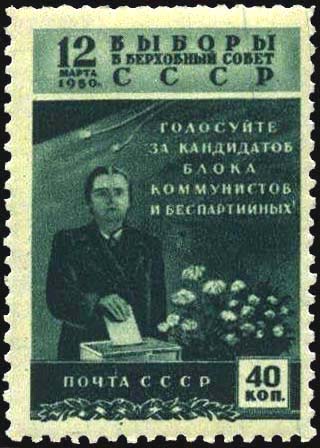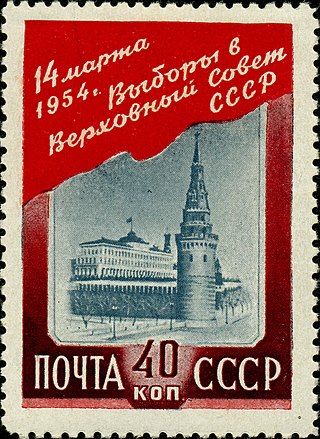
The Supreme Soviet of the Union of Soviet Socialist Republics was, beginning in 1936, the most authoritative legislative body of the Union of Soviet Socialist Republics (USSR), and the only one with the power to approve constitutional amendments. Prior to 1936, the Congress of Soviets was the supreme legislative body. During 1989–1991 a similar, but not identical structure was the supreme legislative body. The Supreme Soviet elected the USSR's collective head of state, the Presidium, and appointed the Council of Ministers, the Supreme Court, and the Procurator General of the USSR.

The Republic of Uzbekistan is a presidential constitutional republic, whereby the President of Uzbekistan is head of state. Executive power is exercised by the government and by the Prime Minister of Uzbekistan.
The 1977 Constitution of the Soviet Union, officially the Constitution of the Union of Soviet Socialist Republics, was the constitution of the Soviet Union adopted on 7 October 1977.

The political system of the Soviet Union took place in a federal single-party soviet socialist republic framework which was characterized by the superior role of the Communist Party of the Soviet Union (CPSU), the only party permitted by the Constitution.

A seven-question referendum was held in Belarus on 24 November 1996. Four questions were put forward by President Alexander Lukashenko on changing the date of the country's independence day, amending the constitution, changing laws on the sale of land and the abolition of the death penalty. The Supreme Council put forward three questions on constitutional amendments by the Communist and Agrarian factions, local elections and the national finances.

Parliamentary elections were held in Russia on 12 December 1993. They were the first parliamentary elections in post-Soviet Russia and the only time to the Federation Council, with future members appointed by provincial legislatures and governors.
Supreme Soviet elections were held in the Lithuanian SSR on 24 February with run-off elections on 4, 7, 8 and 10 March 1990 to elect the 141 members of the Supreme Soviet. In six constituencies, voter turnout was below the required minimum and a third round was held on 17 and 21 April. For the first time since 1940 elections to the People's Seimas, non-communist candidates were allowed to run. The elections were the first free nationwide elections since 1926, and only the fifth free elections in all of Lithuanian history.

The electoral system of the Soviet Union was varying over time, being based upon Chapter XIII of the provisional Fundamental Law of 1922, articles 9 and 10 of the 1924 Constitution and Chapter XI of the 1936 Constitution, with the electoral laws enacted in conformity with those. The Constitution and laws applied to elections in all Soviets, from the Supreme Soviet of the Soviet Union, the Union republics and autonomous republics, through to regions, districts and towns. Voting was claimed to be secret and direct with universal suffrage. However, in practice, before 1989, voters could vote against candidates preselected by the Communist Party only by spoiling their ballots, whereas votes for the party candidates could be cast simply by submitting a blank ballot.

The Government of the Soviet Union, formally the All-Union Government of the Union of Soviet Socialist Republics, commonly abbreviated to Soviet Government, was the executive and administrative organ of state in the former Soviet Union. It had four different names throughout its existence; Council of People's Commissars (1923–1946), Council of Ministers (1946–1991), Cabinet of Ministers and Committee on the Operational Management of the National Economy. It also was known as Workers-Peasants Government of the Soviet Union during the Stalin era.
Elections to the eleventh Supreme Soviet were held in the Soviet Union on 4 March 1984. They were the last in the Soviet Union to be held before Mikhail Gorbachev's policies of perestroika and demokratizatsiya resulted in partially free elections in 1989. They were also the last direct elections to the Supreme Soviet, as in 1989 deputies were elected to the Congress of People's Deputies, who then elected the Supreme Soviet.
Elections to the Supreme Soviet were held in the Soviet Union on 14 June 1970.
Elections to the seventh Supreme Soviet were held in the Soviet Union on 12 June 1966.

Elections to the Supreme Soviet were held in the Soviet Union on 12 March 1950.

Elections to the Supreme Soviet were held in the Soviet Union on 14 March 1954.
Elections to the Supreme Soviet were held in the Soviet Union on 16 March 1958.

The Congress of People's Deputies of the Soviet Union was the highest body of state authority of the Soviet Union from 1989 to 1991.
Elections to the Supreme Soviet were held in the Soviet Union on 18 March 1962.
Elections to the Supreme Soviet were held in the Soviet Union on 16 June 1974.
Parliamentary elections were held in Romania on 30 November 1952. They were the second held under undisguised communist rule, and the first under a constitution adopted that September. They were also the first held after longtime Prime Minister Petru Groza handed the post to Gheorghe Gheorghiu-Dej, who as leader of the communist Romanian Workers' Party (PMR) had been the country's de facto leader since the communists seized full power in 1947.
Parliamentary elections were held in Romania on 9 March 1975. The Front of Socialist Unity, dominated by the Romanian Communist Party and including other mass organisations, was the only organisation that contested the election. No prospective candidate could run for office without the Front's approval. The Front won all 349 seats in the Great National Assembly.








